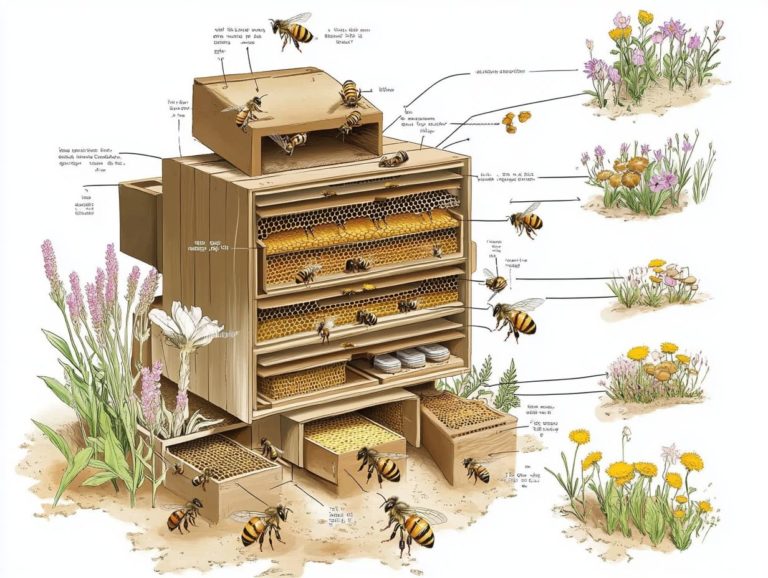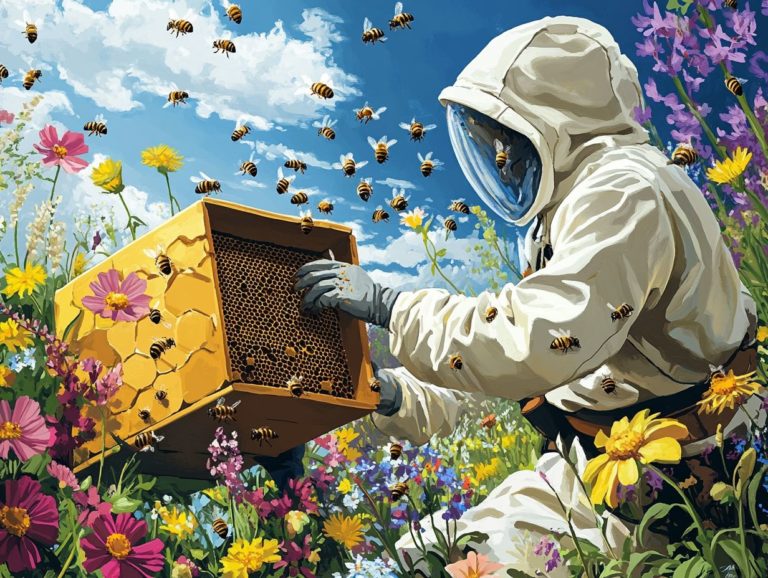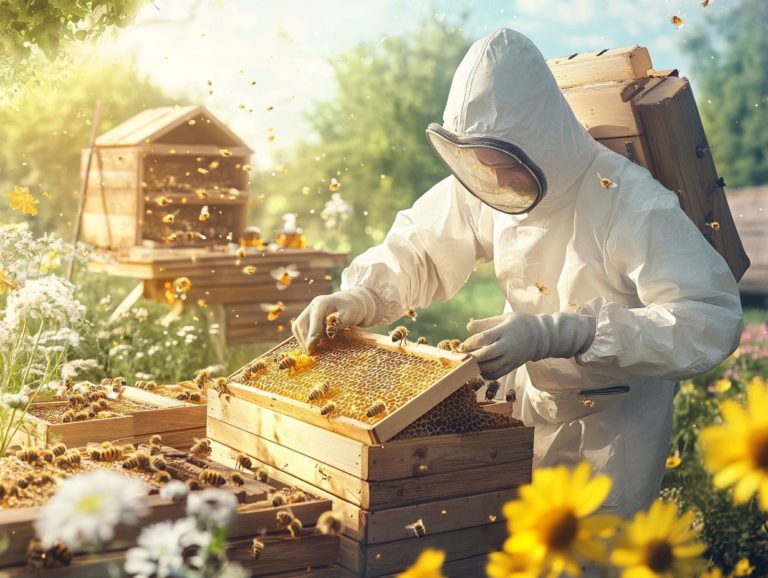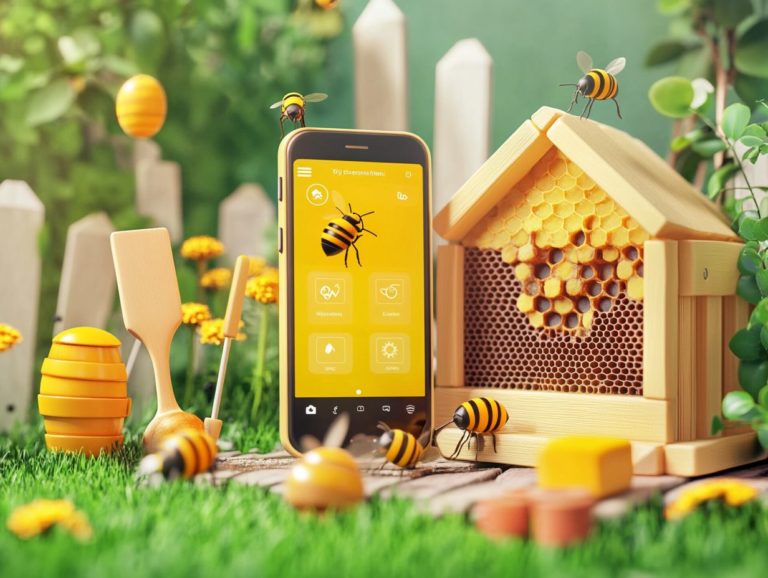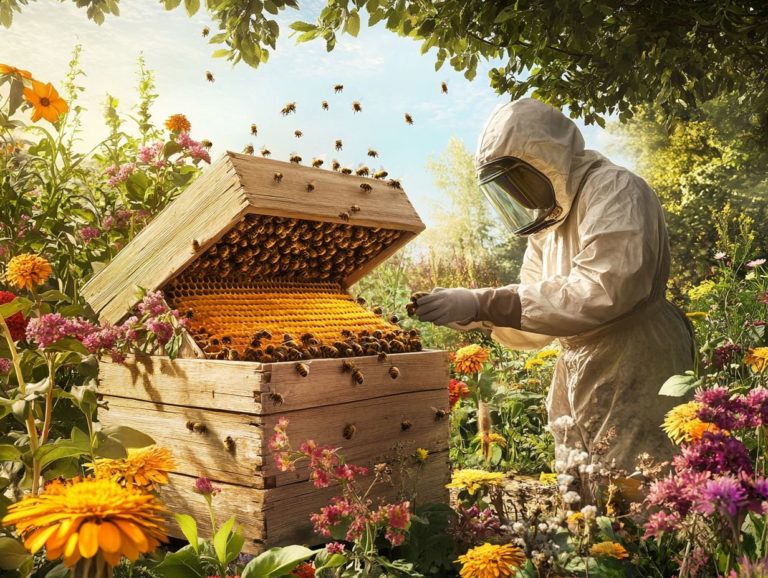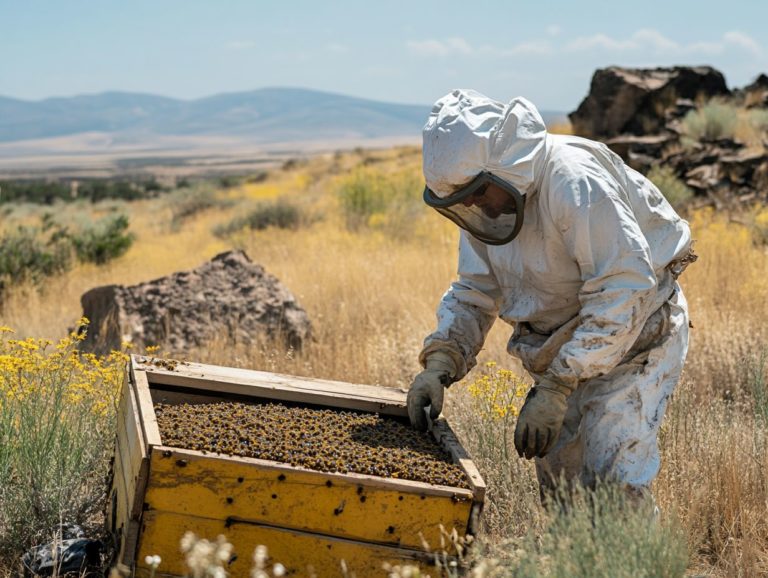When to Requeen Your Hive
Requeening your hive is an essential component of successful beekeeping, one that can profoundly influence the health and productivity of your colony. This process ensures the removal of the old queen and the introduction of a new queen, enhancing hive productivity and overall colony health.
If your queen is aging, displaying aggressive behavior, or not producing enough brood, it s vital to recognize these signs and know when to take decisive action. Identifying these issues early can make the requeening process more efficient and successful.
This article delves into the reasons for requeening, the optimal times to undertake this task, methods of requeening, how to identify when it s necessary, and the steps to effectively introduce a new queen.
Jump in now to boost your hive’s honey production and see your colony thrive!
Contents
Key Takeaways:
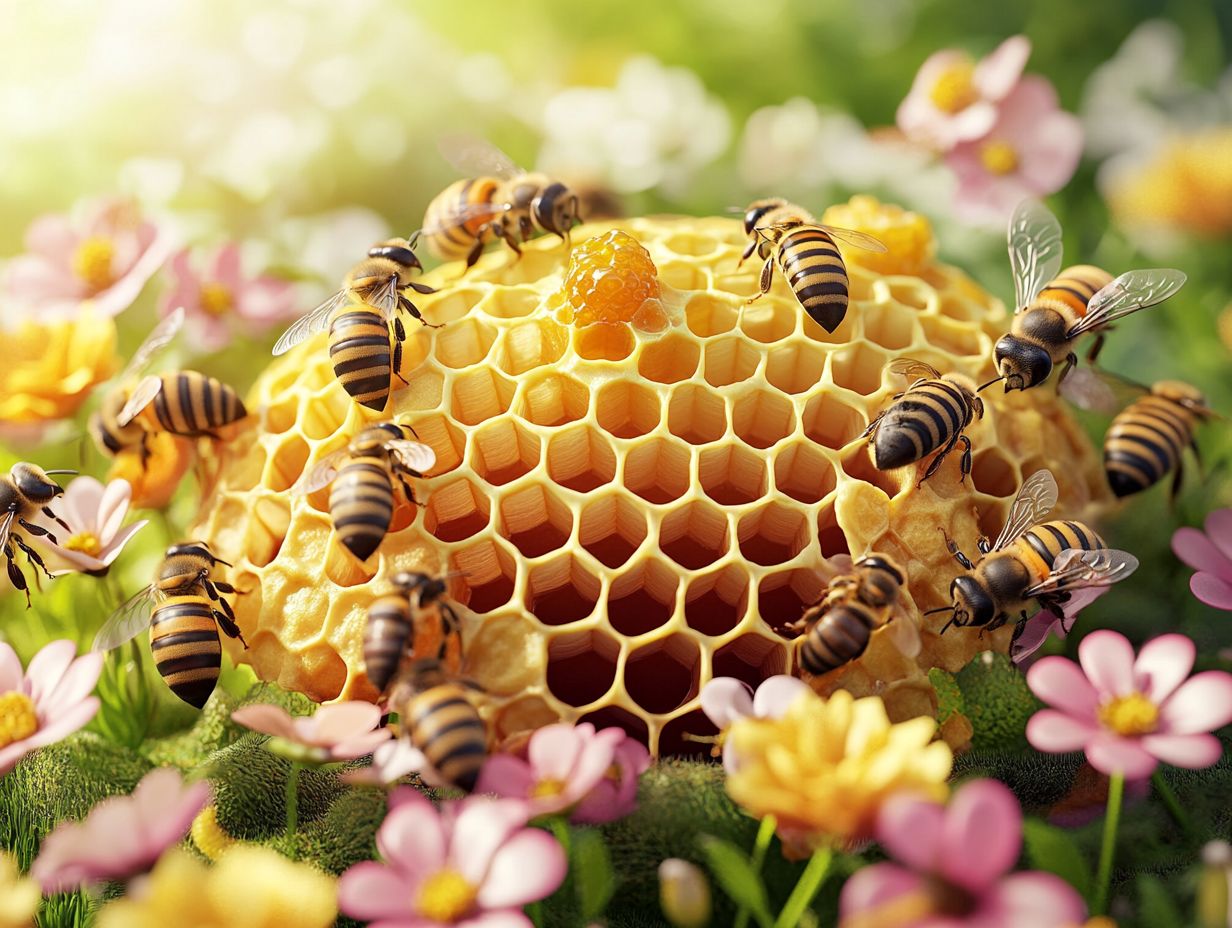
- Requeening is important for maintaining a healthy and productive hive.
- The best time to requeen is in late spring, early summer, or fall, and it can also prevent swarming and manage diseases.
- Signs that your hive needs requeening include decreased egg production, aggressive behavior, poor brood pattern, and presence of queen cells.
- To requeen, purchase a new queen and carefully introduce her to the hive using either direct release or indirect introduction methods, then monitor the hive for any issues.
Why Requeen Your Hive?
Requeening your hive is an essential aspect of effective beekeeping that can significantly elevate the health and productivity of your colony. A thriving queen bee is vital for the vitality of your hive. She plays a direct role in the colony’s ability to produce honey and sustain a strong population.
The queen’s genetics influence the colony’s traits, making the selection of a new queen crucial for future success. It’s important for you, as a beekeeper, to recognize when requeening is necessary, whether it’s due to an aging queen, aggressive behavior, or a noticeable drop in productivity.
By understanding the benefits of introducing a new queen, you can foster a more harmonious and productive environment within your hive, ultimately leading to the success of your apiary.
1. Old or Failing Queen
An aging or failing queen can significantly hinder the growth and productivity of your bee colony, as her egg-laying capabilities and the production of healthy bee brood tend to wane with time.
When you begin to notice a drop in egg production or irregular brood patterns, those signs might suggest that your queen is no longer operating at her best. Such challenges can result in a dwindling population of foraging bees, which in turn affects your honey production.
This is where methods of requeening, such as raising queens or sourcing from a queen breeder, become critical. To revitalize the colony, effective queen replacement becomes essential.
You might consider methods such as introducing a new queen or raising a queen from eggs laid by a more successful queen. Installing a mated queen or using a caged queen can also help in ensuring the new queen is accepted by the worker bees.
Keeping a robust bee brood is vital to ensuring the overall health of your hive. This enables you to nurture a thriving, resilient colony that can withstand environmental challenges and support apiary expansion.
Use these insights to take action and ensure your hive remains healthy and productive!
2. Aggressive or Poorly Performing Queen
An aggressive or underperforming queen can create a temperamental hive environment. This leads to increased stress among your worker bees and diminishes the overall productivity of the colony.
This heightened tension disrupts the natural harmony within the hive. It results in erratic behaviors among the workers and a decline in efficiency.
When faced with a queen exhibiting aggressive tendencies, your workers may respond defensively. This response hampers foraging efforts and raises the risk of swarming.
If the queen struggles to fulfill her laying duties effectively, the colony may begin to develop workers that lay eggs, complicating the dynamics even further. In such cases, the requeening benefits become apparent as replacing the aggressive queen with a young queen can restore harmony and increase hive productivity.
To assess queen performance, observe brood patterns and the overall behavior of the hive. Evaluating how well a newly introduced queen is accepted is crucial; ensuring a smooth transition can lead to improved harmony and productivity within your hive.
Utilizing direct release or indirect introduction methods can help in this process.
3. Swarm Prevention
Swarm prevention is an essential strategy in your beekeeping endeavors. Swarming can result in the loss of a significant portion of your colony’s population, which in turn affects honey production and the overall stability of your hive.
Effective hive management practices and regular inspections can help identify and mitigate conditions that lead to swarming. By implementing effective requeening practices, you can significantly minimize the formation of queen cells, a precursor to swarming.
When a thriving colony starts to feel overcrowded, the bees instinctively create these cells in preparation for dividing their community. Introducing a young queen into the hive brings higher vitality and a more prolific egg-laying rate, fostering a balanced population.
This balance curbs the urge to swarm and enhances the overall health of your colony, ensuring that productivity and resilience remain at their peak.
4. Disease Management
Mastering disease management is key to thriving in beekeeping! Requeening can significantly enhance this process by introducing queens with superior genetics.
This approach aids in disease resistance and promotes the genetic diversity necessary for a resilient hive. Thoughtfully selecting and introducing new queens helps foster a healthy hive environment.
Utilizing caged queens during the introduction phase ensures a smoother transition, allowing your worker bees to gradually acclimate to their new matriarch. Implementing consistent hive management practices can reduce disease risks.
Regular inspections, feeding bees with sugar water, and effective mite control measures tiny pests that can harm your bees are essential for nurturing a thriving colony that yields impressive honey production.
When is the Best Time to Requeen?
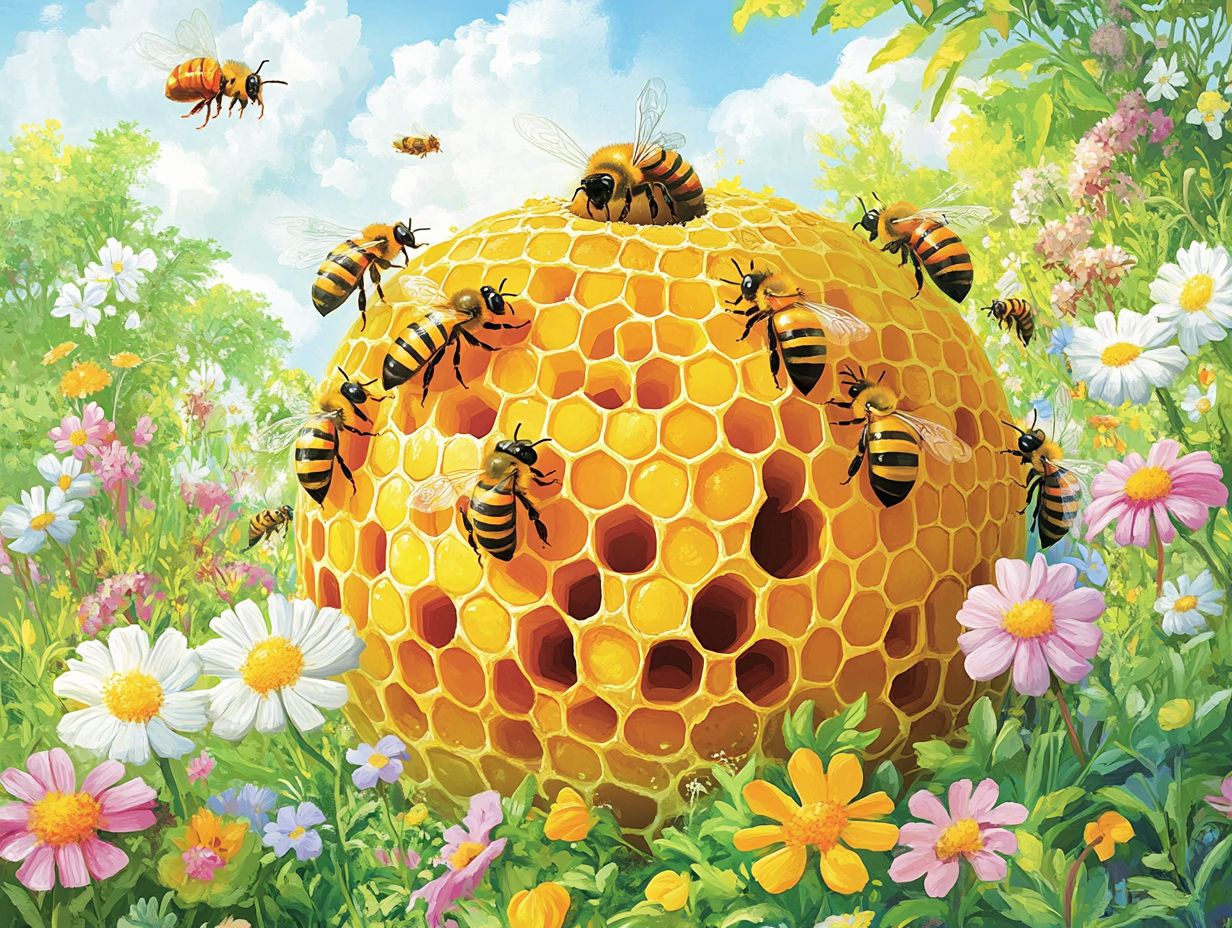
Don’t miss the opportunity! Timing your requeening efforts is crucial for boosting your colony’s health and productivity. Late spring, early summer, and fall emerge as the optimal periods for introducing a new queen, ensuring that your colony thrives under her leadership.
1. Spring
Spring presents itself as the perfect opportunity for requeening. The warmer temperatures and heightened foraging activity create an ideal atmosphere for introducing new queens. This season is conducive to successfully installing a new queen due to the abundance of blooms and nectar sources.
During this vibrant season, the hive buzzes with energy, boosting foraging, which helps the colony grow. With the arrival of blooms and nectar sources, a new queen can significantly improve the colony’s population dynamics, which refers to how many bees are in the colony and how they grow. This transition not only rejuvenates the genetic diversity within the hive but also strengthens its resilience against diseases and pests. Ensuring the new queen’s acceptance is crucial for a smooth requeening process.
By implementing effective hive management practices during this period, you can ensure a smooth integration of the queen. This helps her lay eggs more effectively while the workers enthusiastically support her, resulting in a thriving colony that’s ready to take on the summer.
2. Summer
Summer presents an excellent opportunity for requeening, but you must be diligent in your monitoring to ensure that the queen is accepted and that your colony remains healthy.
During the warmer months, as hive activity surges, you’re faced with both challenges and unique opportunities. Introducing a young queen can truly rejuvenate a colony, yet it demands your careful observation to guarantee she’s embraced by the existing worker bees. Using queen cells and regular feeding with sugar water can aid in this process.
Keeping your hive productive is essential, particularly as the foraging season reaches its peak. Regular assessments of the colony’s behavior and food stores are vital, along with monitoring the dynamics among the bees to reduce the risk of aggression.
These practices will not only facilitate a smooth transition but also bolster the overall vitality of your hive as it prepares for the seasons ahead.
3. Fall
While fall may not be the most popular season for requeening, with a bit of strategic planning, you can still successfully introduce new queens before winter arrives.
As you navigate this process, be thoughtful as you plan your requeening. The dwindling populations and the impending cold months can complicate hive management, so mindfulness is key. Spotting queen cells might suggest that the colony is ready to welcome a new leader, but it could also reveal underlying issues that require your attention. Ensuring there are enough frames of brood and resources is vital for the new queen’s success.
Ensuring that your colony remains robust and healthy is of utmost importance; overlooking their wellbeing could put their survival at risk during the winter months. Act quickly to evaluate your hive’s conditions, make necessary adjustments, and introduce a new queen well ahead of the first frost so she can establish herself and lay a healthy brood. This period is also ideal for monitoring any potential supersedure activities within the hive.
How to Tell if Your Hive Needs Requeening
Determining whether your hive needs requeening is essential for sustaining a healthy and productive colony. Several key indicators can signal this need, prompting you to take action as a discerning beekeeper.
1. Decreased Egg Production
Decreased egg production serves as a key indicator that your hive may require requeening, often signaling an aging or failing queen. Beekeepers should be vigilant about maintaining a proper requeening schedule to address these issues promptly.
Monitoring egg production metrics is essential for maintaining the colony’s health, as a sustained decline can lead to significant challenges. When egg counts drop below average, it not only casts doubt on the queen s reproductive capabilities but may also hint at potential issues with the development of bee larvae. An older or underperforming queen may struggle to lay the necessary number of eggs. This can eventually lead to a queenless hive if not addressed in time.
This situation can escalate, leading to signs of instability within the colony, including the emergence of laying workers who assume the egg-laying role when the queen is unable to perform her duties. By proactively assessing these metrics, you position yourself to take the necessary actions before circumstances spiral out of control.
Make it a habit to inspect your hive regularly to ensure it’s thriving!
2. Aggressive Behavior

Aggressive behavior among worker bees can be a telling sign of underlying issues with the queen. This often suggests that requeening may be necessary due to poor acceptance or temperament.
These aggressive behaviors can stem from various factors, including genetic predispositions, environmental stressors, or diseases impacting the colony. As a beekeeper, closely observe not only the queen s temperament but also the overall dynamics within the hive. A lack of harmony can intensify aggressive tendencies, leading to further complications.
To evaluate queen acceptance effectively, monitor the bees’ reactions after introducing the queen. Ensure that the hive environment remains stable free from disturbances that could provoke aggression. By maintaining consistent conditions and fostering a healthy relationship between the queen and her worker bees, you lay the groundwork for a peaceful hive atmosphere.
3. Poor Brood Pattern
A poor brood pattern serves as a critical indicator that requeening is necessary. This often reflects the queen’s genetics and the colony’s overall productivity.
A healthy brood pattern shows evenly spaced eggs, larvae, and pupae. This arrangement is essential for your colony’s vitality. It s a clear sign that your queen is functioning at her best, effectively utilizing resources and maintaining a robust hive.
In contrast, irregular brood patterns can lead to fewer worker bees and diminished hive performance. The emergence of laying workers complicates the situation further, as their erratic egg-laying behaviors pose a significant threat to the colony’s future.
By introducing a genetically strong queen, you can restore order, improve brood patterns, and enhance overall colony resilience. This move ultimately secures the hive s successful continuation.
4. Queen Cells Present
The presence of queen cells in your hive can be a telling sign that it s time for requeening. This indicates that the colony may be gearing up for supersedure or swarming events.
Supersedure is when a colony replaces an old queen with a new one. Swarming is when a colony splits to form a new colony. These cells are vital signals for you as a beekeeper, pointing towards potential issues like a failing queen or a hive that s just too crowded.
When a colony senses that their queen isn’t performing at her best, they’ll often take matters into their own hands and initiate her replacement to ensure the hive’s survival and productivity.
Requeening is crucial don t wait until it s too late to replace a failing queen! It involves careful observation and precise timing to keep disruption within the colony to a minimum. In this scenario, strategic hive management becomes paramount. Addressing the root causes that lead to the formation of queen cells will help you maintain the long-term health and stability of your colony.
How to Requeen Your Hive
Requeening your hive requires a series of meticulous steps to ensure success. Begin by selecting a new queen that meets your preferences. Once you ve made your purchase, the next step is to introduce her to the hive with care.
After the introduction, it’s essential to monitor the hive closely. Observe how well the new queen is accepted and how she adapts to her new environment. Each of these steps is crucial for a thriving colony.
1. Purchase a New Queen
Purchasing a new queen is the essential first step in the requeening process. Choosing a young queen from a reputable breeder can greatly elevate the genetic quality of your colony.
When searching for a new queen, it s vital to prioritize her vitality and proven productivity. A quality queen should embody traits such as high egg production, disease resistance, and a calm temperament. These attributes all play a role in fostering a thriving hive.
The genetics of the queen not only impact her immediate offspring but also determine the long-term health and productivity of the colony. Thus, sourcing from reliable breeders is crucial. These professionals typically employ rigorous selection processes to ensure that their queens exhibit desirable traits.
Being well-informed about the purchasing process will save you time and enhance the chances of successfully integrating a new queen into your existing colony.
2. Introducing the New Queen
Introducing the new queen to your hive requires thoughtful planning. Often, beekeepers use a caged queen, meaning a queen bee kept in a small cage, to help the colony accept her. This method allows the bees to get used to her scent, reducing the risk of aggression.
Another approach is direct release, where the queen is simply placed into the hive. However, this method carries a higher risk of rejection. It s important to weigh your options carefully. Understanding the behavior of your colony is crucial; aggressive or recently disturbed hives may be less accepting of a new queen.
After introducing the queen, monitor the hive closely for signs of acceptance. Watch for the exciting moment when your queen mingles happily with the workers, which indicates she s been welcomed. On the flip side, act quickly if you see noticeable aggression or a lack of activity near the queen, as this could mean your hive is rejecting her.
3. Monitoring the Hive After Requeening
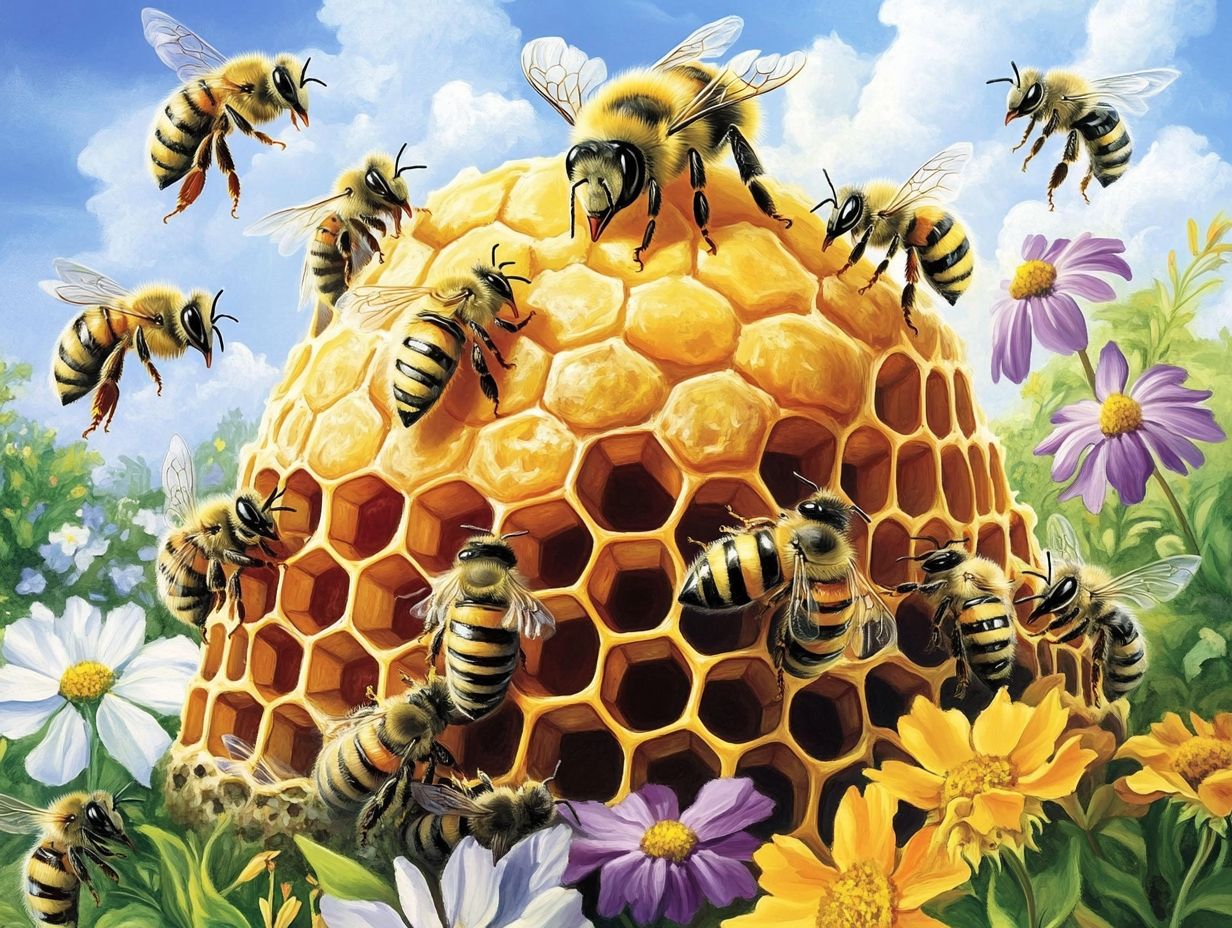
Monitoring your hive after the requeening process is essential to ensure that the new queen is embraced and that the health and productivity of the colony are restored.
You can gauge a successful queen acceptance through several indicators, such as the presence of eggs, larvae, and the serene demeanor of the worker bees. By observing the colony’s behavior, you gain valuable insights into their response to the new queen. For example, if you see the worker bees nurturing brood and actively foraging, it s a strong sign that they have welcomed her. Conversely, if you notice aggression or an absence of brood, it may signal underlying issues that need addressing.
Maintaining ongoing hive management practices, including regular inspections and ensuring a sufficient food supply, is crucial to supporting the new queen and enhancing the hive s resilience during this transition period.
Frequently Asked Questions
When should I consider requeening my hive?
You should consider requeening your hive if your current queen is showing signs of declining health, your hive is underperforming, or if you want to introduce new genetics to your colony.
What are some signs that my queen needs to be replaced?
Signs that your queen needs to be replaced include a decrease in egg laying, excessive drone brood, aggressive behavior, and a dwindling population in the hive.
How often should I requeen my hive?
It is generally recommended to requeen your hive every 1-2 years to ensure a healthy and productive colony. However, some beekeepers may choose to requeen more frequently for specific reasons, such as introducing new genetics.
What is the best time of year to requeen a hive?
The best time of year to requeen a hive is in the spring when the colony is building its population and preparing for the honey flow. This allows the new queen to establish herself and for the colony to thrive during the busy season.
Can I requeen my hive during a nectar dearth?
It is not recommended to requeen your hive during a nectar dearth, as this can cause stress and disruption to the colony. It is best to wait until the honey flow is in full swing before introducing a new queen.
What is the process for requeening a hive?
The process for requeening a hive involves first locating the current queen and removing her, then introducing the new queen to the colony. This can be done using various methods, such as a queen cage or newspaper method. It is important to monitor the acceptance of the new queen and make any necessary adjustments.

